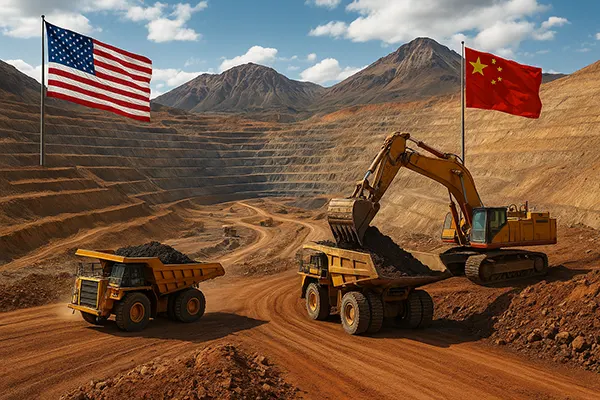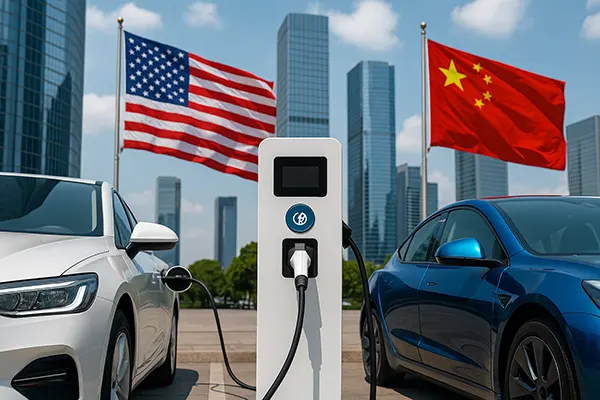
The Battle for Rare Earths: A New Chapter in the US-China Economic Rivalry
The strategic importance of rare earth elements has thrust them into the heart of a renewed economic confrontation between the United States and China. These essential minerals, vital to the production of advanced electronics, military systems, and green energy technologies, have become both an asset and a weapon in a growing geopolitical struggle. As of June 2025, the global rare earths landscape reflects intensifying competition, with serious implications for economic security, technological sovereignty, and international trade dynamics.
China’s Dominance and Its Strategic Leverage
China currently controls approximately 70% of global rare earths production and processing capacity, a position it has maintained through extensive state support, resource investment, and a robust export infrastructure. This dominance has enabled Beijing to influence market supply and prices, effectively turning these minerals into a geopolitical bargaining chip.
Over the years, China has demonstrated its readiness to use rare earths strategically. In previous trade disputes, export restrictions have been used to exert pressure. Today, with geopolitical tensions escalating, Beijing’s rare earths policy continues to be a potential lever of economic influence, especially over nations reliant on these critical materials.
The Chinese government’s latest moves include investments in downstream supply chains and the development of rare earth-heavy components domestically, ensuring added value stays within China’s industrial ecosystem. At the same time, export controls are becoming more targeted, with growing scrutiny over buyers and end uses.
Risks and Global Dependency
The global dependency on Chinese rare earths has raised alarm bells, especially in Washington and allied capitals. Despite initiatives aimed at diversifying supply, the cost, complexity, and environmental challenges of rare earths mining remain substantial. Alternatives are limited and not easily scalable in the short term.
Industries most exposed to this dependency include defence, automotive (particularly EVs), and renewable energy sectors. A sudden disruption in rare earths trade could lead to production delays, increased costs, and strategic vulnerabilities across critical supply chains.
To mitigate this risk, several countries have introduced policies to incentivise rare earths extraction and processing domestically or through trusted partners. However, breaking China’s monopoly remains a long-term endeavour requiring sustained investment and international coordination.
US Response and Strategic Investment
The United States has responded to the rare earths challenge with an aggressive push for self-reliance. The Inflation Reduction Act, CHIPS Act, and bipartisan legislative initiatives have channelled billions of dollars into domestic resource development, clean energy, and strategic minerals.
In 2025, key mining projects in Texas, California, and Alaska are receiving federal support to accelerate the extraction and refining of critical minerals. Simultaneously, partnerships with Australia, Canada, and the EU aim to establish secure supply corridors, backed by long-term procurement contracts and joint ventures.
At the federal level, the Pentagon continues to prioritise rare earths under its defence production strategy, ensuring secure access for sensitive military technologies. Recent policy directives mandate diversified sourcing and reduced reliance on Chinese-origin materials in defence and aerospace procurement.
Challenges in Building Capacity
Despite progress, the US faces numerous obstacles. Building out rare earths infrastructure takes years, and environmental permitting, public opposition, and capital requirements remain significant hurdles. As a result, the US still relies heavily on imported materials for its domestic needs.
Technological gaps in refining and separation also limit the competitiveness of Western producers. While investments in R&D are increasing, scaling commercially viable and environmentally responsible processing technologies remains a critical bottleneck.
Labour and expertise shortages further complicate the effort. The highly specialised nature of rare earths metallurgy requires trained engineers, geologists, and processing experts, which are in short supply across the West.

Outlook and Global Realignment
As rare earths become increasingly entwined with national security, the global economy is witnessing a shift in strategic alliances and investment priorities. New entrants such as India, Vietnam, and Brazil are positioning themselves as alternative suppliers, seeking foreign capital and technical know-how to monetise their reserves.
In response, China is also diversifying its upstream operations abroad, securing stakes in mines across Africa and Southeast Asia. This outbound strategy allows Beijing to maintain its control over supply chains while bypassing geopolitical chokepoints.
Meanwhile, international institutions are pushing for the creation of a transparent, sustainable rare earths market. This includes traceability standards, environmental safeguards, and anti-monopoly frameworks aimed at ensuring fair competition and supply chain resilience.
Future Scenarios and Strategic Implications
The rare earths contest is emblematic of a broader decoupling trend in US-China economic relations. The race for supply chain autonomy may lead to new trade blocs and strategic technology alliances, reshaping global commerce in the years ahead.
If the West succeeds in diversifying supply and scaling processing capacity, China’s leverage may gradually erode. However, until then, Beijing retains a powerful position that it can weaponise if tensions escalate further.
Ultimately, rare earths will continue to play a pivotal role in the global economic order. The race to control these strategic resources is not only about technology but also about influence, power, and the future balance of geopolitical stability.
